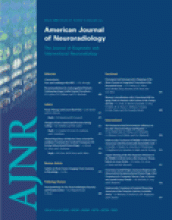Abstract
BACKGROUND AND PURPOSE: The imaging features of metastatic melanomas are distinctive due to the presence of melanin and the propensity for hemorrhage. Both hemorrhage and melanin can produce T1-weighted hyperintensity and T2*-weighted signal intensity loss. We hypothesized that T2*-weighted images would improve detection of metastatic melanoma.
METHODS: The T2* and T1 characteristics of 120 newly detected metastatic brain lesions from 31 patients with malignant melanoma were compared with those of 120 brain metastases from 23 patients with lung cancer.
RESULTS: Melanoma metastases were 5 times more likely to demonstrate prominent T2*-related signal intensity loss (susceptibility effect) than were lung metastases (42% vs 8%; P < .01), and 4.5 times more likely to demonstrate T1 hyperintensity (55% vs 12%; P < .01). Patients with melanoma had lesions that were either hypointense on T2*-weighted images, hyperintense on T1 images, or both, in 71% (85/120), compared with 19% (23/120) of lung carcinoma metastases (P < .01). Melanoma lesions were 16 times more likely than lung cancer lesions to show combined T2* related signal intensity loss and T1 hyperintensity (P < .01). Remarkably, 8 melanoma lesions (7%) in 3 patients were detectable principally on the T2*-weighted sequences, whereas no lung cancer lesion was detected solely on susceptibility images. We found a direct correlation between melanin content and T1 hyperintensity but no correlation between T2* intensity and melanin.
CONCLUSION: T2*-weighted images improve lesion detection in patients with melanoma metastases, and in conjunction with T1-weighted sequences, can suggest melanoma as the etiology of an intracranial mass. This sequence should be employed for evaluation of possible brain metastasis in patients without a known primary malignancy and in studies for melanoma staging.
- Copyright © American Society of Neuroradiology












